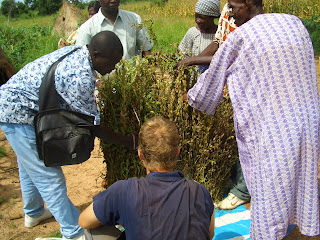Sesame Harvest 2009
During June and July I accompanied my association in the distribution of seeds and the advising of best practices in the planting, maintanence, spacing, harvesting, drying and storing of sesame seeds. Most of this seed will be exported to the U.S. providing several of these farmers with much needed cash, given that many of their other crops are solely for self-consumption or crop for crop trade.
So, with the arrival of October and the start of the harvest season here in Burkina I thought I would show you all a little bit about the harvesting of sesame. The earliest any farmers I work with had planted this year was the first week of July, and so around 70 days later of fairly consistant, and ideally not to heavy, rainfall the farmers in these photos were cutting their sesame plants to begin drying them in the sun for around 10 days. The sesame plant is spread out on plastic tarps to dry in the sun, and after several days the drying pods, which are left on the plant, will begin opening up on their own and the seeds then fall, or are shaken out, onto the tarps. Now the seeds can be picked through to filter out the inferior, and much less valuable, smaller and darker seeds. The seeds will be put into 100 kilogram (220 pound) sacks before heading off to markets.

So, with the arrival of October and the start of the harvest season here in Burkina I thought I would show you all a little bit about the harvesting of sesame. The earliest any farmers I work with had planted this year was the first week of July, and so around 70 days later of fairly consistant, and ideally not to heavy, rainfall the farmers in these photos were cutting their sesame plants to begin drying them in the sun for around 10 days. The sesame plant is spread out on plastic tarps to dry in the sun, and after several days the drying pods, which are left on the plant, will begin opening up on their own and the seeds then fall, or are shaken out, onto the tarps. Now the seeds can be picked through to filter out the inferior, and much less valuable, smaller and darker seeds. The seeds will be put into 100 kilogram (220 pound) sacks before heading off to markets.








